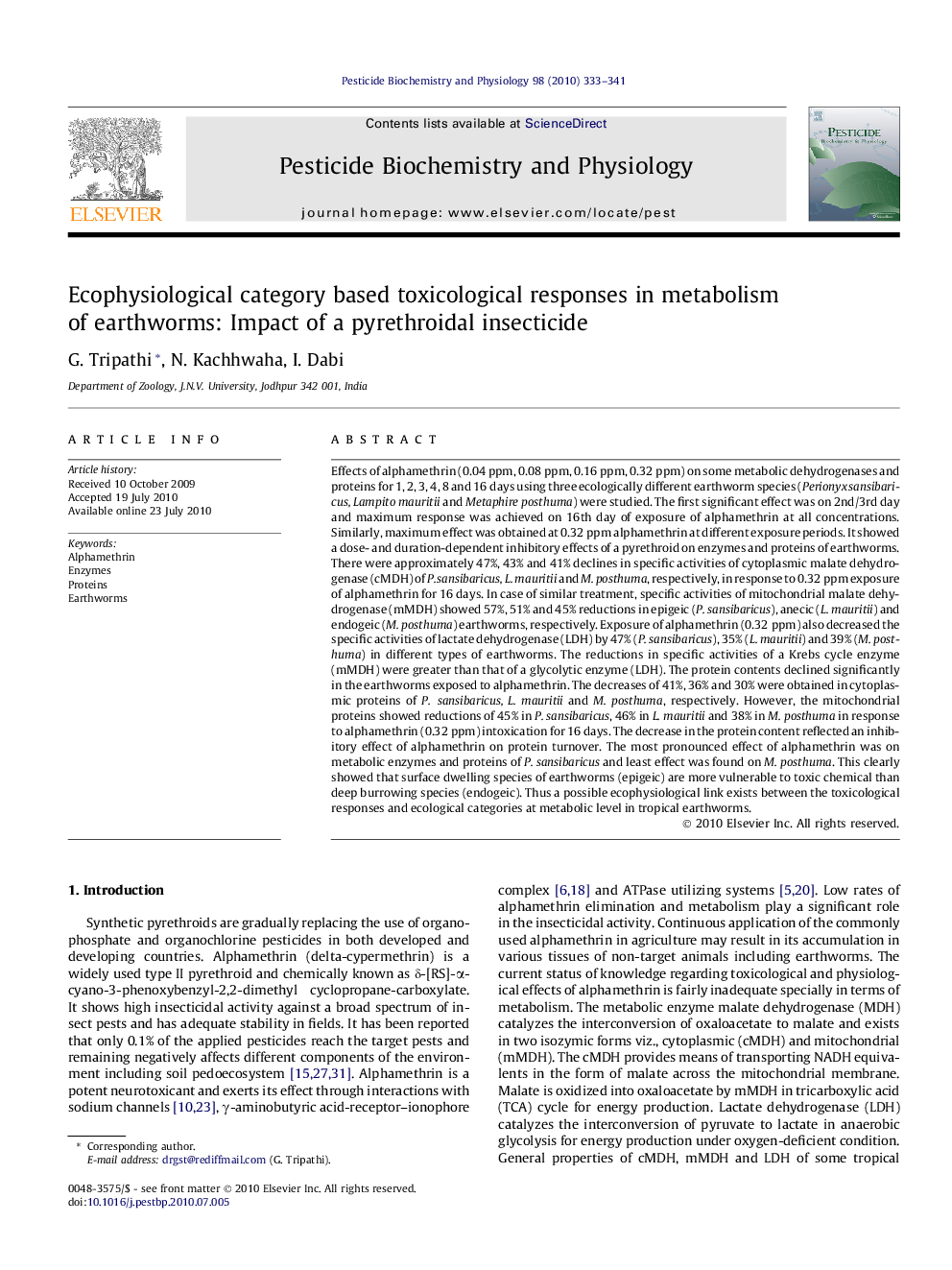| کد مقاله | کد نشریه | سال انتشار | مقاله انگلیسی | نسخه تمام متن |
|---|---|---|---|---|
| 2010013 | 1066704 | 2010 | 9 صفحه PDF | دانلود رایگان |
عنوان انگلیسی مقاله ISI
Ecophysiological category based toxicological responses in metabolism of earthworms: Impact of a pyrethroidal insecticide
دانلود مقاله + سفارش ترجمه
دانلود مقاله ISI انگلیسی
رایگان برای ایرانیان
موضوعات مرتبط
علوم زیستی و بیوفناوری
علوم کشاورزی و بیولوژیک
علوم زراعت و اصلاح نباتات
پیش نمایش صفحه اول مقاله

چکیده انگلیسی
Effects of alphamethrin (0.04Â ppm, 0.08Â ppm, 0.16Â ppm, 0.32Â ppm) on some metabolic dehydrogenases and proteins for 1, 2, 3, 4, 8 and 16Â days using three ecologically different earthworm species (Perionyx sansibaricus, Lampito mauritii and Metaphire posthuma) were studied. The first significant effect was on 2nd/3rd day and maximum response was achieved on 16th day of exposure of alphamethrin at all concentrations. Similarly, maximum effect was obtained at 0.32Â ppm alphamethrin at different exposure periods. It showed a dose- and duration-dependent inhibitory effects of a pyrethroid on enzymes and proteins of earthworms. There were approximately 47%, 43% and 41% declines in specific activities of cytoplasmic malate dehydrogenase (cMDH) of P. sansibaricus, L. mauritii and M. posthuma, respectively, in response to 0.32Â ppm exposure of alphamethrin for 16Â days. In case of similar treatment, specific activities of mitochondrial malate dehydrogenase (mMDH) showed 57%, 51% and 45% reductions in epigeic (P. sansibaricus), anecic (L. mauritii) and endogeic (M. posthuma) earthworms, respectively. Exposure of alphamethrin (0.32Â ppm) also decreased the specific activities of lactate dehydrogenase (LDH) by 47% (P. sansibaricus), 35% (L. mauritii) and 39% (M. posthuma) in different types of earthworms. The reductions in specific activities of a Krebs cycle enzyme (mMDH) were greater than that of a glycolytic enzyme (LDH). The protein contents declined significantly in the earthworms exposed to alphamethrin. The decreases of 41%, 36% and 30% were obtained in cytoplasmic proteins of P. sansibaricus, L. mauritii and M. posthuma, respectively. However, the mitochondrial proteins showed reductions of 45% in P. sansibaricus, 46% in L. mauritii and 38% in M. posthuma in response to alphamethrin (0.32Â ppm) intoxication for 16Â days. The decrease in the protein content reflected an inhibitory effect of alphamethrin on protein turnover. The most pronounced effect of alphamethrin was on metabolic enzymes and proteins of P. sansibaricus and least effect was found on M. posthuma. This clearly showed that surface dwelling species of earthworms (epigeic) are more vulnerable to toxic chemical than deep burrowing species (endogeic). Thus a possible ecophysiological link exists between the toxicological responses and ecological categories at metabolic level in tropical earthworms.
ناشر
Database: Elsevier - ScienceDirect (ساینس دایرکت)
Journal: Pesticide Biochemistry and Physiology - Volume 98, Issue 3, November 2010, Pages 333-341
Journal: Pesticide Biochemistry and Physiology - Volume 98, Issue 3, November 2010, Pages 333-341
نویسندگان
G. Tripathi, N. Kachhwaha, I. Dabi,